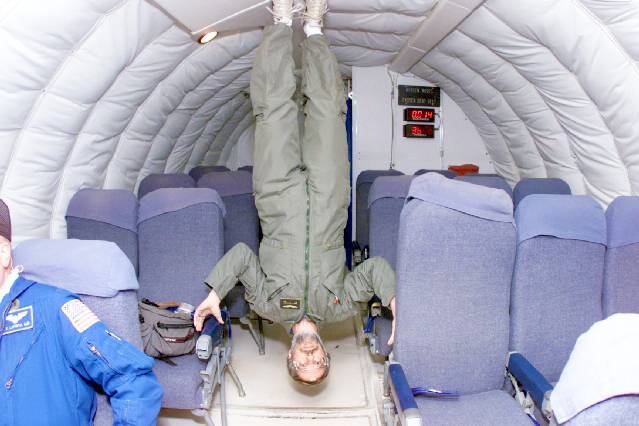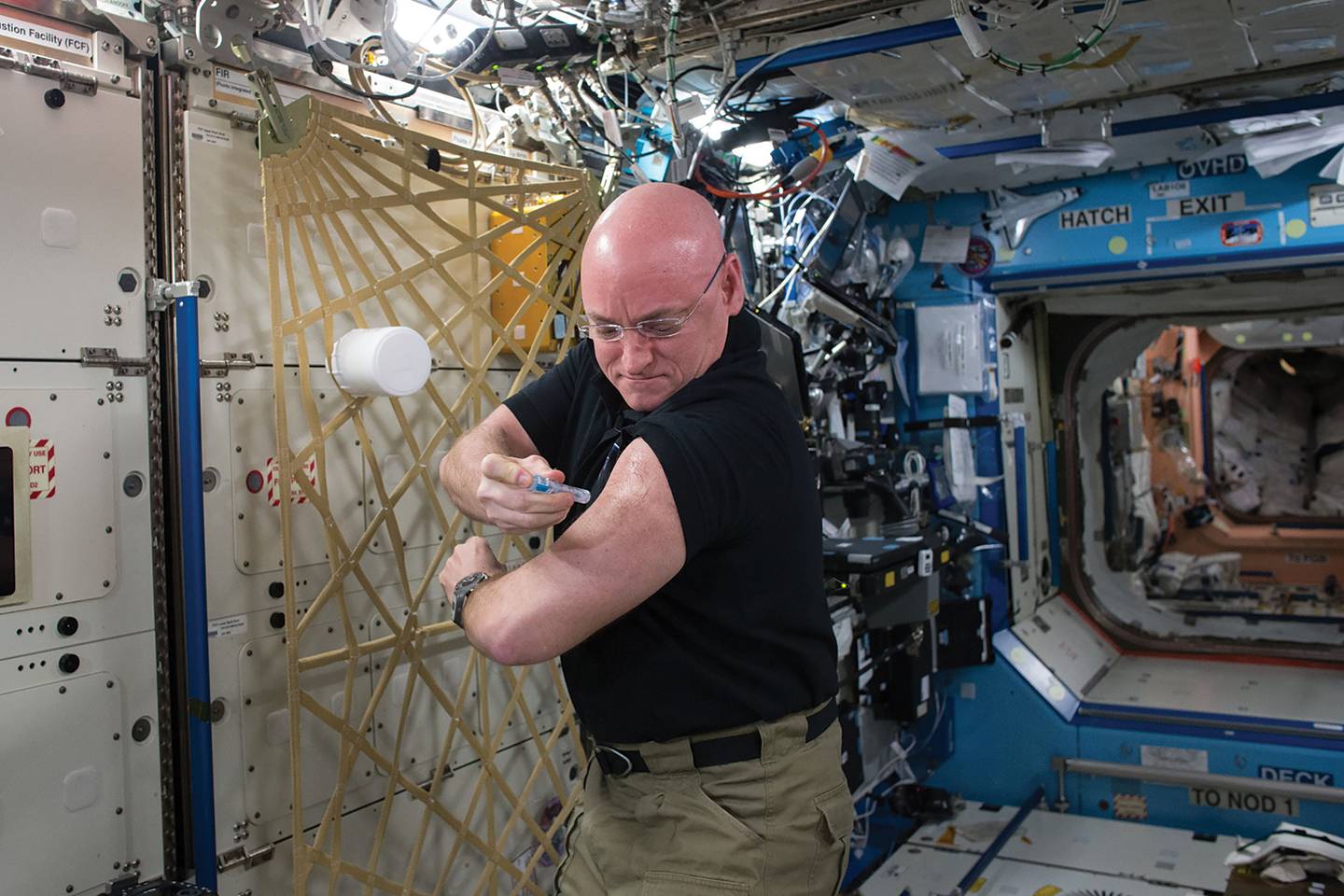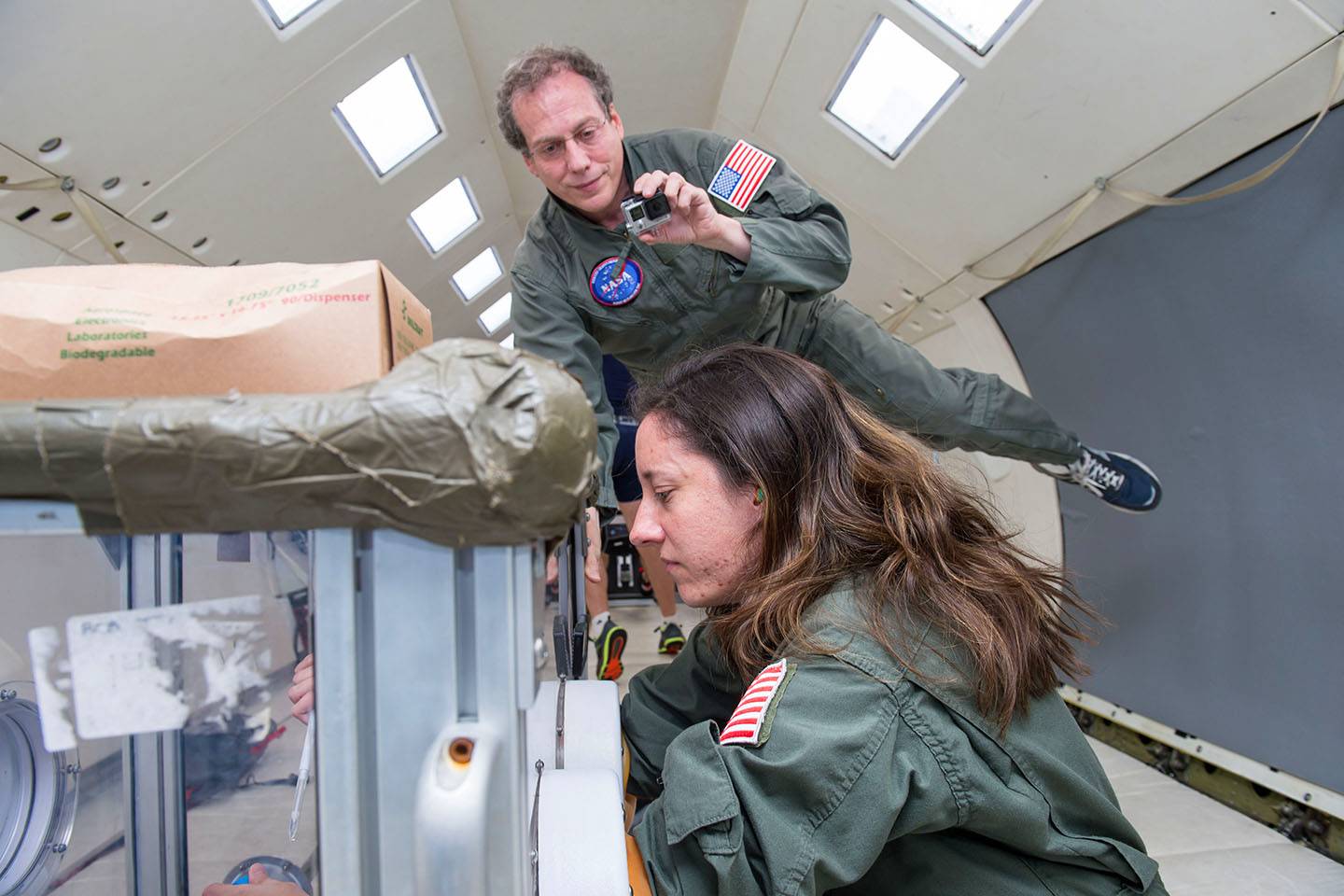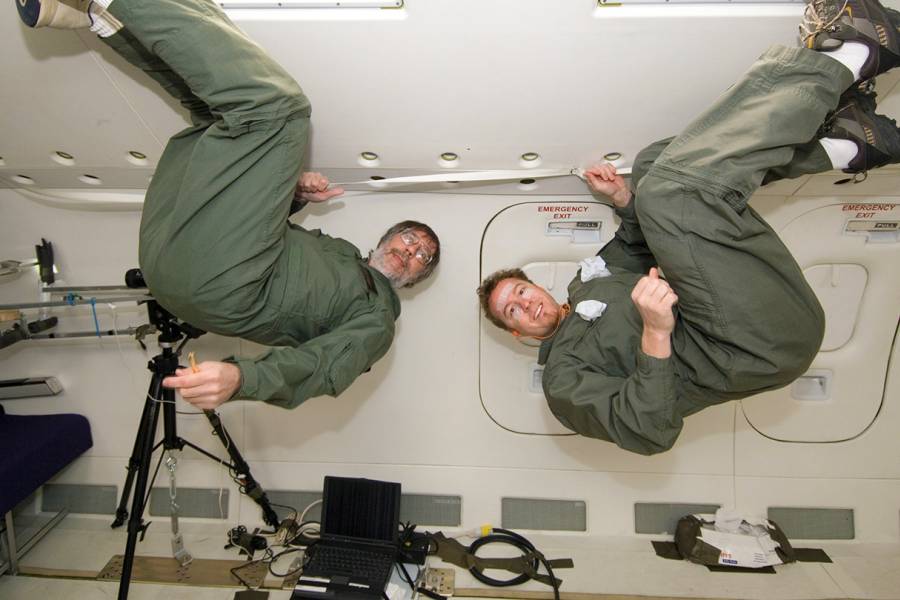On July 20, 1969, Mark Shelhamer watched the televised broadcast of the Apollo astronauts landing on the moon along with 600 million other folks on Earth—including his mother, who worried Neil Armstrong would take his famous leap only to sink into the moon, buried by lunar dust. Shelhamer was 10 years old, full of excitement and awe—and with exactly zero concern for any harm to Armstrong or his fellow Apollo crew members.
Fifty years later, there is arguably more momentum for human space travel than at any time since that day in 1969. NASA has pledged to send astronauts back to the moon by 2024—not just to visit, but to create a permanent human settlement and a launch pad to Mars in 2033. Commercial companies Virgin Galactic and Blue Origin plan to hurtle civilians into suborbital space for a glimpse of Earth and a taste of zero gravity by year-end. And in March, a SpaceX spacecraft completed a successful test mission, making it likely the company will begin shuttling American astronauts to the International Space Station this summer. In the entire history of human spaceflight, only 571 people have been to space, and only 12 have stepped on another planetary body. That number is about to grow exponentially.

Image credit: Bryce Wymer
These developments delight Shelhamer, who, at 60, retains his boyish zeal for human spaceflight. But they also deeply concern him. In 2013, he took a leave from the School of Medicine, where he's an associate professor of otolaryngology, to serve as chief scientist of NASA's Human Research Program. In that post, he got up close and personal with exactly how the harsh conditions of space imperil the fragile human corpus. Bones and muscles weaken. The immune system goes haywire. Without the pull of gravity, fluid pools in the head, causing damage to the structure of the eye. And, as recently discovered, time in space changes humans at their most fundamental level: their genes.
Of all the threats to health and human performance on long space voyages, NASA has identified two as the most serious: exposure to space radiation and the behavioral risks of being trapped with a small group of people in a tin can, far from home. As chief scientist, Shelhamer oversaw research to understand and mitigate those risks. As he puts it, "NASA wants to send people to the moon and Mars without killing them, or them killing each other."
Now that he's returned to Hopkins, Shelhamer is enlisting his colleagues to help NASA do exactly that: use their expertise to help prepare humans for life far beyond the Earth's protective atmosphere.
"It's about preventive medicine, making sure the crew is as healthy as they can be when they start, and trying to detect things before they become problems," he says. "It's about medicine and engineering, about using statistics to make decisions based on probability. It's much more than just figuring out how many Band-Aids and pills to take to Mars."
In 1981, when the space shuttle Columbia first shot into space, Shelhamer was an engineering student at Drexel University so obsessed with space travel that he stayed up all night reading technical reports from the Apollo, Mercury, and Gemini missions. "It's like a good magic trick," he says, referring to the Apollo missions. "The more I learned, the more amazed I was that it could even be done." He assumed his passion for space would be just a hobby, until he discovered Massachusetts Institute of Technology's Man Vehicle Laboratory (now the Human Systems Laboratory), which was seeking graduate students to investigate how the brain's vestibular system—the part of the ear that senses the speed and direction of the body's movement and regulates balance—adapts to gravity changes.

Image caption: Shelhamer, inverted in the aisle of NASA's zero-gravity aircraft
Image credit: Courtesy of Mark Shelhamer
Since then, Shelhamer has devoted much of his professional career to studying the body's vestibular adaptations in space. He's participated as a graduate student in experiments that were sent up on two Spacelab flights and clocked 80 flights on NASA's parabolic aircraft, aka the vomit comet, which simulates zero gravity. One of those flights was in the company of his wife, Jennifer Wiseman, the senior project scientist for the Hubble Space Telescope at NASA's Goddard Space Flight Center, whom he met at MIT. They have a long-running, but friendly, rivalry over which type of spaceflight should be higher priority. He argues for manned and she for unmanned.
In 2013, when a friend forwarded Shelhamer the posting for the chief scientist job and urged him to apply, Shelhamer thought it was crazy. There was no way he was qualified. And when NASA offered him the two-year position, he planned to turn it down because it meant moving to Houston while Wiseman stayed in Maryland—and he didn't want to be away from her. "I was pacing outside our house and I came in and told my wife I'd decided not to do it," he says. "She said, 'Look, space has always been a part of our lives. It's what we do. Our marriage is strong, we'll get through this.'" She also reminded him: "You'll be overseeing the experiments on the space station. How cool is that?"
It was very cool. After years of being immersed in his specialized niche of human spaceflight research, Shelhamer suddenly had a holistic view of NASA's entire human research program from the highest level.
But the chief scientist job was stressful. Shelhamer had never been a manager before. There were too many meetings, and too few chances to engage in the deep intellectual satisfaction of doing science. And, he says, he became convinced that the health risks of human spaceflight have to be studied as a system of cross-disciplinary, interrelated factors, not as individual problems. "The thing that's going to kill someone in space is going to be an interaction of separate problems," he says. "You can have the individual problems solved, but there's a domino effect and the next thing you know someone is dead."
Since returning to his faculty position at Hopkins in 2016, Shelhamer has continued with his research. He has an eight-year NASA grant to monitor the vestibular adaptations of astronauts spending up to a year on the ISS. But he spends most of his time on his new mission, which is to create a Center for Space Life Sciences at Hopkins. "I'm essentially trying to create a miniature NASA human research program here," he says. "With a world-class medical school, strong engineering program, the [Johns Hopkins] Applied Physics Laboratory, and the School of Arts and Sciences, we can hit the major human health and performance issues, and do it in an integrative cross-disciplinary way." The center Shelhamer envisions would build upon the university's existing space studies program Space@Hopkins, directed by astrophysicist Charles L. Bennett, but focus specifically on human and biological space science.
Without the resources or authority to create such a center from the top down, Shelhamer is building support from the ground up, relying on financial support from the Whiting School of Engineering's Commercial and Government Program Office and a lot of gumshoe detective work to identify scientists whose research could relate to human spaceflight. Part Don Quixote, part carnival barker, part fixer, he spends hours each day calling and emailing scientists across Hopkins. "I have this conversation with everyone I can find: 'Hey, there's a NASA grant solicitation ... I can help you tap into a new funding source,'" he says.
It's not an easy sell. Funding is tight. NASA's budget for human health and performance research is minuscule compared to that of the NIH. Impact is small. Why would a scientist want to investigate health issues that affect a handful of astronauts when there are diseases that affect millions here on Earth? And, all research has to be tied to a health risk. "Doing science for NASA is not like doing basic science. It's risk mitigation to keep people safe in space."
Yet for Shelhamer, these challenges are trumped by an unwavering belief in the value of human space travel. "Human spaceflight is inspiring in a unique way," he says. "It expands the human experience."
On a rainy Tuesday afternoon in February, in the basement of a research building on the East Baltimore campus, Shelhamer has gathered six Hopkins scientists, who've never met, to discuss space radiation. He begins by introducing Catherine M. Davis and Robert Hienz, researchers in the Division of Behavioral Biology in the Department of Psychiatry and Behavioral Sciences in the School of Medicine, as "the only people in the room to get paid by NASA for radiation work." Davis and Hienz investigate the effects of radiation on the brain by studying the cognitive performance of rats exposed to a radiation dose comparable to what humans would sustain during a two-year space voyage. Nearly half the rats exposed to radiation in the study, which was published in the March 2014 issue of Radiation Research, showed attention lapses and delays in reaction time for months afterward, but the rest were seemingly unaffected, says Davis. This tells us there might be individualized susceptibility to radiation. Human translation: Some people may be more harmed by space radiation than others. "If we can understand the biological mechanism behind the changes from radiation," Davis says, "it could inform a countermeasure—whether pharmacological or cognitive—that could protect astronauts on missions to the moon or Mars, or help them recover when they return."
Davis has barely finished explaining her work when Adam Kaplin, an assistant professor of psychiatry and behavioral sciences, says, "I'm sorry, I can't wait any longer. Have you looked at inflammatory markers?"
Davis shakes her head. Mike Wang, a graduate student in neuroimmunology and adjunct faculty at the School of Arts and Sciences who works with Kaplin, says, "I'm about to explode. It's amazing how much what you're saying dovetails with what we're doing."
Kaplin and his team study the relationship between neuroinflammation and depression in patients with multiple sclerosis. Though it might seem MS would have little to do with astronauts, Kaplin says radiation exposure causes complicated damage all over the body. "MS is a very good model for looking at what the nervous system will do when it's constantly unhappy in a whole-body way," he says.
Kaplin has never done human spaceflight research before. But just a week prior to this basement meeting, he presented at a conference hosted by the Translational Research Institute for Space Health, known as TRISH, which funds research to preserve astronaut physical and mental wellness during deep space exploration missions. And simultaneously, Wang began wondering how Kaplin's work could help protect his brother, a mechanical engineering student and Air Force airman who is on a path to become an astronaut. "In digging through the literature about the brain under exposure to extreme environments, I realized our lab has a lot to offer," says Wang. "Everything about space threatens to increase neuroinflammation."
As his colleagues discuss the harmful effects of radiation, Radame?s J.B. Cordero sits in the back of the room, listening intently before explaining that melanin, a natural material found in all kingdoms of life that's known to protect organisms from high levels of ionizing radiation, could shield humans from radiation in the first place. "People living on Mars could eat melanin capsules, which could provide internal shielding for the gut and organs," says Cordero, a research associate in the Molecular Microbiology and Immunology Department at Johns Hopkins Bloomberg School of Public Health. "Melanin could also be used as a structural material in the shuttles, habitats, and spacesuits to provide external protection."
Melanin could also be used as a renewable, organic heat source, he says. In a study published last summer in Current Biology, Cordero and his team showed that black melanotic fungi heated twice as fast and twice as hot as white fungi when exposed to radiation. "We already knew melanin was efficient in absorbing radiation," he says. "But this study was the first time that we could control many of the confounding variables and show how effective melanin is at capturing heat." Another big plus for melanin: It's easily transportable. "You could bring a tiny Q-tip of melanin and it will grow and replicate in space," Cordero says.
In the front of the room, Shelhamer beams. These are exactly the kinds of cross-disciplinary conversations he wants to foster and support through his Center for Space Life Sciences—and exactly the kinds of collaborations he believes can successfully address the health risks of human spaceflight. In the coming weeks and months, he'll guide these researchers in applying for funding for human spaceflight research, drawing on his NASA experience to help them navigate the system. He's also working with ophthalmology Professor Neil Bressler and engineering Professor Phillipe Burlina on a proposal to analyze retinal imaging data from astronauts on the ISS to detect early onset of medical conditions related to "spaceflight-associated neuroocular syndrome," or SANS.
But Shelhamer isn't only recruiting Hopkins faculty into the human spaceflight field. He's also building interest in students. Currently, he mentors Serena Tang, a rising senior majoring in neuroscience and physics, who is working with him on a study funded by an undergraduate research award and a NASA grant. Tang had never considered human spaceflight research until she heard Shelhamer present a lecture in 2016, and now she's "99% sure" she wants a career in the field. So does medical student Ben Johnson, who, along with fellow Johns Hopkins medical student David Mampre, created a student interest group devoted to aerospace medicine.
"I find aerospace medicine to be extremely fascinating because it touches on almost every aspect of medicine, from neurology to nutrition, and requires you to rethink the subject in the context of outer space and extreme conditions," says Johnson, who is currently on leave from Hopkins studying for degrees in neuropsychology and space physiology in Europe as a Marshall Scholar. "Between zero gravity, radiation, and extended times in space, every mundane issue on Earth is transformed into something exciting and new."
When Johnson and Mampre invited Shelhamer to be the adviser for their group, they figured it was a long shot. He had been chief scientist for NASA after all. Turns out Shelhamer had been hoping for such an invitation. The group has hosted speakers and visited the Hubble Telescope mission control center where, thanks to his wife, Shelhamer has an "in." Like Shelhamer, Johnson and Mampre believe that student interest in human spaceflight research will grow as private space companies forge forward and the push to reach Mars heightens.
"The goal of medicine is to prolong life," Mampre says. "Space medicine is the epitome of that goal: extending life beyond Earth."
If radiation is the most serious risk to human health on long space voyages, the effects on cognition and mood are a close second. "We're talking about a small number of people, in a small space, at a long distance, for a long duration. And no chance to turn around," says Shelhamer. That means the potential for extreme boredom, homesickness, depression, and interpersonal conflict, issues that may seem minor compared to the threat of cancer or vision problems but aren't. Depressed crew members can't perform tasks, make decisions, or work together to survive in an inhospitable environment.

Image caption: NASA astronaut and twins study participant Scott Kelly gives himself a flu shot in September 2015 while on NASA’s one-year mission aboard the International Space Station.
Image credit: NASA
Shelhamer is working with APL scientists Ariel Greenberg and John Gersh on a proposal to investigate personalized mixed/augmented/virtual reality environments and activities that could offer sensory and task experiences, like exercise and ship maintenance, and help improve social cohesion through games like a virtual treasure hunt.
He's also working with Mike Rosen, a human factors psychologist in the School of Medicine's Armstrong Institute for Patient Safety and Quality, to develop tools to identify individuals who function most effectively as part of a team in a stressful situation. With funding from NASA, Rosen is currently running a study that uses a variety of unobtrusive biosensors—wrist monitors, location sensors, and a speech analysis app—to monitor two groups of astronaut analogs working in stressful situations: crew members spending 45 days living in a simulated Mars environment inside NASA's Human Exploration Research Analog, known as HERA, at Johnson Space Center, and physician teams in an intensive care unit at Johns Hopkins Hospital. The biosensors collect physiological data on each subject as they go through their days, dealing with long work hours, potential crises, and lots of decision-making. Shelhamer and his students will help decipher the data to identify relationships between different physiological responses and potential early signals of a breakdown in the group dynamic. Since a subject can't "game" his or her physiological responses over a long period of time, Rosen believes the study could be helpful in determining which of NASA's astronaut candidates will function best in a team setting.
"For these longer missions NASA is planning, everything gets more important. You want to pick people where the risk of interpersonal conflict is minimized, people who can survive and thrive as part of a social unit. Not stir up trouble," says Rosen. "Picking an astronaut crew is much less like picking an airline crew or combat crew than picking a family."
In other words, it's complicated. Like everything to do with human spaceflight.
In 2015, Shelhamer was serving as chief scientist when NASA launched the "twins study," in which astronaut Scott Kelly was monitored during 340 days aboard the ISS while his identical twin Mark underwent the same measures back on Earth. The study presented an extraordinary chance to understand the effects of space on the human body. Because Scott and Mark Kelly share identical DNA, any changes in Scott could be attributed to his time in space. Ten research teams from across the country analyzed the Kelly brothers' stools, urine, and blood to look for changes in metabolism, immune response, gut biome, and genetic makeup. Hopkins geneticist and Bloomberg Distinguished Professor Andrew Feinberg led a team that analyzed the Kelly brothers' blood for changes in levels of DNA methylation, the process by which cells "turn on and turn off" gene expression.

Image caption: Feinberg (left) and Rizzardi spent a week aboard NASA's vomit comet, a modified Boeing jet that simulates the weightlessness of the space station
Image credit: Johns Hopkins Medicine
Astronauts on the ISS are accustomed to drawing their own blood samples, which are frozen and transported back to Earth. But since frozen blood doesn't yield good quality DNA for genomic testing, Feinberg's team had to develop a procedure by which Scott Kelly could separate the cells in his blood while on the ISS. To do that, Feinberg and Lindsay Rizzardi, a senior scientist at HudsonAlpha Institute for Biotechnology who was then a postdoctoral fellow working with Feinberg, spent two days aboard NASA's vomit comet learning how to separate blood in zero gravity. "A digital display above the cockpit displayed what the gravity was," says Rizzardi. "Andy was watching it, and when it got to zero he told me and I had 25 seconds to use the pipette to transfer the cells in the blood from one tube to another."
For Feinberg, floating in zero G was the culmination of a dream. In 1979, he applied "on a lark" to become an astronaut along with 7,000 others. He was part of a group of 70 that made it to the second round. "But there wasn't another recruitment for three years," he says, "and in the interim I discovered altered DNA methylation in cancer and decided I'd rather work on that." While Feinberg was giddily doing "superman poses" on the parabolic flights, Rizzardi says she was trying not to throw up—and failing. She and Feinberg tested a portable genetic sequencer, proving that positive displacement pipettes work in space—and becoming the first people to sequence genes in zero gravity.
Once the methodology was set, the challenge was coordinating blood draws with the Russian's Soyuz spacecraft schedule. Scott Kelly would draw his sample on the same day the spacecraft returned to Kazakhstan. From there, it was flown to Houston, transported to the lab at Johnson Space Center, processed, frozen, and shipped to Johns Hopkins. The entire trip took more than 36 hours, Rizzardi says. Not quite one-day Amazon Prime delivery, but close.
Feinberg and Rizzardi expected to find significant changes in Scott's DNA methylation during his time in space, but the data didn't reflect that. Yes, there were fluctuations, but they were in the range of normal. While Rizzardi says the data can be viewed as "a boring negative result, it's pretty cool," she says. "Humans are resilient. It was reassuring." Feinberg would like to do more research for NASA. "It was really great to be part of what is the greatest science project of all time: the project to turn us from a terrestrial species to an interterrestrial species," he says.
The other research teams in the twins study reported far more attention-getting changes in Scott's body during his time in space. His immune system was disrupted, his telomeres lengthened, his cognitive function declined, and the health of his eyes degraded. Most of these changes were temporary, and returned to normal when Scott got back to Earth. But a subset of his genes related to immune function and DNA repair did not bounce back. Researchers believe this is due to damage from space radiation.
Like so much of the research related to human spaceflight, the twins study yielded more questions than answers. But it did provide an answer to one key question: Are humans ready for long-duration space voyages?
Not yet, Shelhamer says.
There's more data to collect, more hypotheses to formulate, more interventions to create, whether it's giving astronauts melanin capsules, or bespoke XR experiences, or medicines to reduce inflammation. But, says Shelhamer, it needs to happen soon. "If we're sending people to Mars in a few decades, we've got to get moving," he says.
So he calls, he emails, he gives his pitch for human spaceflight research to his Hopkins colleagues. All in the hope that decades from now people will watch the first astronauts step on Mars, awed and amazed and assured they are safe.
Posted in Science+Technology
Tagged nasa, space, outer space, space@hopkins









